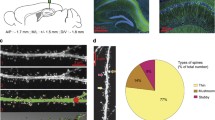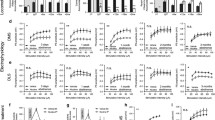Abstract
Contextual cues associated with previous drug exposure can trigger drug craving and seeking, and form a substantial obstacle in substance use recovery. Using in vivo imaging in mice, we found that cocaine administration induced a rapid increase in the formation and accumulation of new dendritic spines, and that measures of new persistent spine gain correlated with cocaine conditioned place preference. Our data suggest that new persistent spine formation in the frontal cortex may be involved in stimulant-related learning driving appetitive behavior.



Similar content being viewed by others
References
McLaughlin, J. & See, R.E. Psychopharmacology (Berl.) 168, 57–65 (2003).
Pierce, R.C., Reeder, D.C., Hicks, J., Morgan, Z.R. & Kalivas, P.W. Neuroscience 82, 1103–1114 (1998).
Tai, L.H., Lee, A.M., Benavidez, N., Bonci, A. & Wilbrecht, L. Nat. Neurosci. 15, 1281–1289 (2012).
Chudasama, Y. & Robbins, T.W. Biol. Psychol. 73, 19–38 (2006).
Robinson, T.E., Gorny, G., Mitton, E. & Kolb, B. Synapse 39, 257–266 (2001).
Robinson, T.E. & Kolb, B. Eur. J. Neurosci. 11, 1598–1604 (1999).
Robinson, T.E. & Kolb, B. Neuropharmacology 47, 33–46 (2004).
Feng, G. et al. Neuron 28, 41–51 (2000).
Hofer, S.B., Mrsic-Flogel, T.D., Bonhoeffer, T. & Hübener, M. Nature 457, 313–317 (2009).
Wilbrecht, L., Holtmaat, A., Wright, N., Fox, K. & Svoboda, K. J. Neurosci. 30, 4927–4932 (2010).
Xu, T. et al. Nature 462, 915–919 (2009).
Kasai, H., Matsuzaki, M., Noguchi, J., Yasumatsu, N. & Nakahara, H. Trends Neurosci. 26, 360–368 (2003).
Bourne, J. & Harris, K.M. Curr. Opin. Neurobiol. 17, 381–386 (2007).
Holtmaat, A.J.G.D. et al. Neuron 45, 279–291 (2005).
Zuo, Y., Lin, A., Chang, P. & Gan, W.-B. Neuron 46, 181–189 (2005).
Knott, G.W., Holtmaat, A., Wilbrecht, L., Welker, E. & Svoboda, K. Nat. Neurosci. 9, 1117–1124 (2006).
Holtmaat, A. et al. Nat. Protoc. 4, 1128–1144 (2009).
Acknowledgements
We thank J. Whistler, P. Janak, S. Jurado, C. Johnson and C. Bates for comments on the manuscript. This work was supported by the National Institute on Drug Abuse (R01DA029150), the State of California, University of California San Francisco, and the P. Royer and K. Clayton Family.
Author information
Authors and Affiliations
Contributions
F.J.M.-C., J.A. and D.P. performed the experiments. L.W. and F.J.M.-C. designed the experiments, analyzed the data and wrote the paper.
Corresponding author
Ethics declarations
Competing interests
The authors declare no competing financial interests.
Supplementary information
Supplementary Text and Figures
Supplementary Figures 1–10 (PDF 1282 kb)
Rights and permissions
About this article
Cite this article
Muñoz-Cuevas, F., Athilingam, J., Piscopo, D. et al. Cocaine-induced structural plasticity in frontal cortex correlates with conditioned place preference. Nat Neurosci 16, 1367–1369 (2013). https://doi.org/10.1038/nn.3498
Received:
Accepted:
Published:
Issue Date:
DOI: https://doi.org/10.1038/nn.3498
- Springer Nature America, Inc.
This article is cited by
-
Reinstatement of nicotine conditioned place preference in a transgenerational model of drug abuse vulnerability in psychosis: Impact of BDNF on the saliency of drug associations
Psychopharmacology (2023)
-
Reversal of Cocaine-Associated Synaptic Plasticity in Medial Prefrontal Cortex Parallels Elimination of Memory Retrieval
Neuropsychopharmacology (2017)
-
Nonmuscle myosin IIB as a therapeutic target for the prevention of relapse to methamphetamine use
Molecular Psychiatry (2016)
-
Drug-Paired Contextual Stimuli Increase Dendritic Spine Dynamics in Select Nucleus Accumbens Neurons
Neuropsychopharmacology (2016)
-
Rule learning enhances structural plasticity of long-range axons in frontal cortex
Nature Communications (2016)





